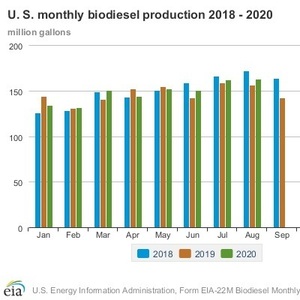US biodiesel production up in August

November 3, 2020
BY Erin Krueger
U.S. biodiesel production reached 163 million gallons in August, up 1 million gallons when compared to the previous month and up 7 million gallons when compared to the same month of 2019, according to data released by the U.S. Energy Information Administration on Oct. 30.
Production in August came from 88 biodiesel plants with a nameplate capacity of 2.5 billion gallons per year. Approximately 73 percent of biodiesel produced in the U.S. in August was manufactured at plants located in the Midwest, within Petroleum Administration for Defense District 2.
Advertisement
According to the EIA, 73 million gallons of biodiesel was sold as B100 in August. An additional 96 million gallons of biodiesel was sold in blends with petroleum diesel.
Approximately 1.239 billion pounds of feedstock was used to produce biodiesel in August, including 745 million pounds of soybean oil, 148 million pounds of corn oil, 44 million pounds of tallow, 55 million bounds of white grease, 80 million pounds of yellow grease, and 26 million pounds of other recycled feedstocks.
Advertisement
Ending stocks of B100 were at 46 million gallons in August, down from 53 million gallons in July. Ending stocks of B100 were at 45 million gallons in August 2019.
Additional data is available on the EIA website.
Related Stories
The USDA significantly increased its estimate for 2025-’26 soybean oil use in biofuel production in its latest World Agricultural Supply and Demand Estimates report, released July 11. The outlook for soybean production was revised down.
U.S. fuel ethanol capacity fell slightly in April, while biodiesel and renewable diesel capacity held steady, according to data released by the U.S. EIA on June 30. Feedstock consumption was down when compared to the previous month.
The U.S. EPA on July 8 hosted virtual public hearing to gather input on the agency’s recently released proposed rule to set 2026 and 2027 RFS RVOs. Members of the biofuel industry were among those to offer testimony during the event.
The USDA’s Risk Management Agency is implementing multiple changes to the Camelina pilot insurance program for the 2026 and succeeding crop years. The changes will expand coverage options and provide greater flexibility for producers.
The USDA’s National Agricultural Statistics Service on June 30 released its annual Acreage report, estimating that 83.4 million acres of soybeans have been planted in the U.S. this year, down 4% when compared to 2024.
Upcoming Events










